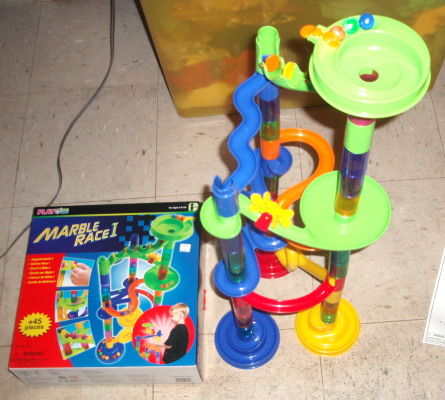
The kids were playing with a marble race game. The game launched three marbles at a time down a series of chutes and tubes. With three children and three marbles the three immediately hit upon the idea that one of the marbles was their marble, and that the first marble down wins. Sitting nearby I said, "That's silly – whichever marble is first at the top will win."

The kids immediately disagreed, showing me that the order at the top is not the order at the bottom. I watched a few runs and noticed that there were two places the marbles changed order. The initial green "whirlpool" and a green dish lower down allowed for changes in marble order.
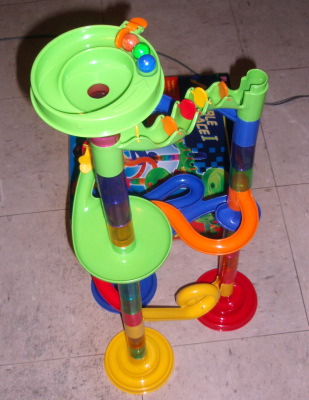
At the top "whirl pool" the marbles orbit the hole. The first marble off the launch rack is not necessarily the first marble to drop.
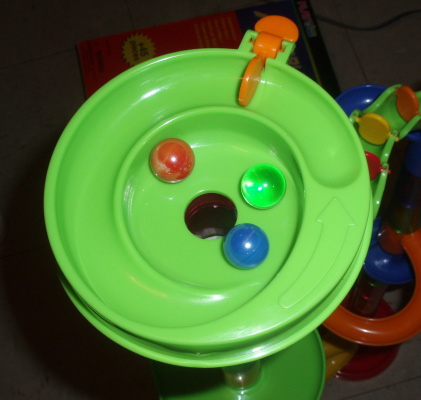
At the lower green "dish" the marbles also orbit, any marble can be the first to enter an opening on the opposite side of the vertical column.
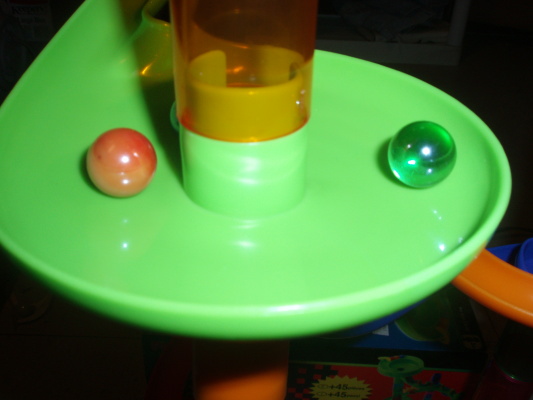
I left the room to go work on some papers from school. About a half an hour later I hear a commotion in the back room. The kids are arguing and fighting over who gets to go second. Go second? I wander into the back. "He always gets to go second, it's not fair" cries one of the kids. Second? I am baffled.
The kids assert that whoever goes second is most likely to win. Being an instructor of statistics, probability, and physical science, I argue that this is only a perception. The human mind perceives patterns where none exist. The kids, however, insist that being the second marble in the launch rack is a benefit.
With the help of the kids, I run an experiment. We launch a set of marbles in the same order, red-green-blue, twenty-one times. They report the finishing order and I record this order. If the marbles are randomly sorted at the bottom, then each marble should take first place about seven times. The red comes in first three times, the green thirteen times, and the blue five times. The kids hunch appears to be correct – being second is an advantage. Still, the sample size is small, and there is nothing about the set that makes it obvious why the marbles would consistently move the second marble up. Could these results still come from a random sample where the distribution is uniform? This is a perfect example of a situation in which a Chi square test is useful. I hadn't run a chi test in a long time, so this was also an opportunity to dust off my own statistical skills shelf.
The following are the observed frequencies and the expected frequencies:
| Observed | First position at finish | Second position at finish | Third position at finish | Expected | First position at finish | Second position at finish | Third position at finish |
|---|---|---|---|---|---|---|---|
| First at start (red) | 3 | 12 | 6 | First | 7 | 7 | 7 |
| Second at start (green) | 13 | 4 | 4 | Second | 7 | 7 | 7 |
| Third at start (blue) | 5 | 5 | 11 | Third | 7 | 7 | 7 |
The resulting statistics were:
Chi statistic: 17.14
P-value: 0.001813
The probability that the observed distribution is the same as the expected distribution, that the marbles sort randomly, is less than 1%. This is not random – the launch order does affect the landing order. Being second at launch is a real and tangible advantage.
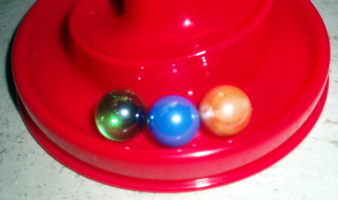
The marbles landing with the second (green) marble in first place
Pohnpei, 08 February 2008